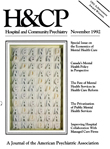The Role of General Hospitals in the Privatization of Inpatient Treatment for Serious Mental Illness
Abstract
For almost three decades, many have regarded general hospital psychiatric units as the most appropriate setting for acute treatment of persons with serious mental illness who were once treated mostly in state hospitals. The extent to which this transfer has taken place and the differences between public and private general hospitals have been unclear. Using data from the 1988 National Mental Health Facilities Study and published data from the 1970s, the authors found that nearly half of all general hospitals providing psychiatric services treat persons with serious mental illness. Significant differences in case and payer mix were observed between public and private general hospitals, although these differences were smaller than in the 1970s. The findings suggest increased involvement by private general hospitals in treating patients reimbursed by public payers, but the findings also indicate that persons with serious mental illness and those using Medicaid are still more prevalent in public general hospitals than in private ones.
Access content
To read the fulltext, please use one of the options below to sign in or purchase access.- Personal login
- Institutional Login
- Sign in via OpenAthens
- Register for access
-
Please login/register if you wish to pair your device and check access availability.
Not a subscriber?
PsychiatryOnline subscription options offer access to the DSM-5 library, books, journals, CME, and patient resources. This all-in-one virtual library provides psychiatrists and mental health professionals with key resources for diagnosis, treatment, research, and professional development.
Need more help? PsychiatryOnline Customer Service may be reached by emailing [email protected] or by calling 800-368-5777 (in the U.S.) or 703-907-7322 (outside the U.S.).



